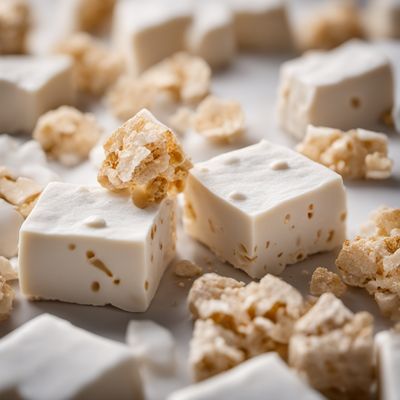
Ingredient
Meringue mixture
"Whipped Clouds: Exploring the Delicate Delights of Meringue Mixture"
Meringue mixture is a combination of egg whites and sugar that is whipped to create a light and fluffy foam. The resulting mixture is glossy, smooth, and has a marshmallow-like texture. It is known for its ability to hold its shape when baked, making it ideal for creating delicate and decorative desserts. Meringue mixture can range in color from pure white to a light golden hue, depending on the baking time. Its taste is sweet, with a subtle hint of vanilla or other flavorings that may be added. The texture is crisp on the outside and soft and chewy on the inside, providing a delightful contrast. Its appearance is often described as ethereal, resembling fluffy clouds or delicate peaks.
Origins and history
The origins of meringue can be traced back to the early 17th century in Europe, particularly in France and Switzerland. It is believed to have been created by an Italian chef named Gasparini, who worked for the French royal family. Meringue gained popularity in the 18th century when it became a favorite dessert among the French aristocracy. It was later introduced to other European countries and eventually made its way to America. Today, meringue is enjoyed worldwide and is an essential component of many classic desserts.
Nutritional information
Meringue mixture is low in calories, with approximately 15 calories per tablespoon. It is fat-free and cholesterol-free. However, it is important to note that meringue mixture is primarily made up of sugar and egg whites, so it should be consumed in moderation as part of a balanced diet.
Allergens
Meringue mixture contains egg whites, making it unsuitable for individuals with egg allergies.
How to select
When selecting meringue mixture, it is best to opt for store-bought options that are made with high-quality ingredients. Look for brands that use fresh egg whites and minimal additives. If purchasing from a bakery or pastry shop, choose meringue mixture that appears fresh, with a glossy and smooth texture. Avoid any meringue mixture that appears discolored or has a grainy texture.
Storage recommendations
To maintain the freshness and quality of meringue mixture, it should be stored in an airtight container at room temperature. Avoid exposing it to moisture or humidity, as this can cause it to become sticky or lose its crispness. Properly stored, meringue mixture can last for up to a week.
How to produce
Amateur bakers can produce meringue mixture by whisking together fresh egg whites and granulated sugar until stiff peaks form. It is important to ensure that the bowl and whisk are clean and free from any traces of grease, as this can prevent the egg whites from properly whipping.
Preparation tips
When preparing meringue mixture, it is crucial to start with room temperature egg whites, as they whip up better than cold ones. Adding a small amount of cream of tartar or lemon juice can help stabilize the mixture and prevent it from deflating. It is important to gradually add the sugar while whisking to ensure it dissolves completely. When piping or shaping the meringue, use a clean and dry piping bag or spoon to create desired shapes. Baking at a low temperature for a longer period of time will result in a crisp exterior and a soft, chewy interior.
Culinary uses
Meringue mixture is commonly used to create desserts such as pavlovas, macarons, and lemon meringue pie. It can also be used as a topping for pies, cakes, and tarts, adding a light and airy texture. Additionally, meringue mixture can be folded into batters to create lighter and fluffier cakes or cookies.
Availability
Meringue mixture is commonly available in grocery stores, specialty baking supply stores, and online retailers. It can also be found in bakeries and pastry shops.
More ingredients from this category » Browse all

Oil seed mass
Golden Elixir

Nut mass
The Power of Nut Mass

Truffle mass
Decadence in a Jar

Marzipan raw mass
The Sweet Almond Delight: Unveiling the Magic of Marzipan

Liquorice mass
The Bold and Bittersweet Delight

Caramel, soft
Silky Sweetness in Every Bite

Nougat raw mass
"The Sweet Delight: Unveiling the Secrets of Nougat Raw Mass"

Florentine biscuit mass
The Delicate Dough

Macaroon mass
Decadent Delights: Exploring the World of Macaroon Mass

White nougat mass
The Sweet Delight: White Nougat Mass

Brittle mass
"Crunchy Delight: Exploring the World of Brittle Mass"

Chocolate mass
Decadent Delight: Exploring the World of Chocolate Mass
Recipes using Meringue mixture

Classic Lemon Meringue Pie
Tangy Citrus Delight: Classic Lemon Meringue Pie

Classic Canadian Flapper Pie
Maple-infused Flapper Delight

Dacquoise with Raspberry Cream
Heavenly Layers: Raspberry Dacquoise Delight

Bolo de Brigadeiro - Brazilian Chocolate Cake
Decadent Delight: Indulge in the Richness of Brazilian Chocolate Cake

Austrian Eierschecke
Viennese Delight: Austrian Eierschecke - A Heavenly Twist on a German Classic

Vegan Chocolate Mousse Cake
Decadent Vegan Chocolate Delight

Meringue Delight
Heavenly Meringue Tart

Ptichye Moloko Cheesecake
Heavenly Russian Ptichye Moloko Cheesecake

Namibian Mess
Savannah Delight: Namibian Mess with a Twist